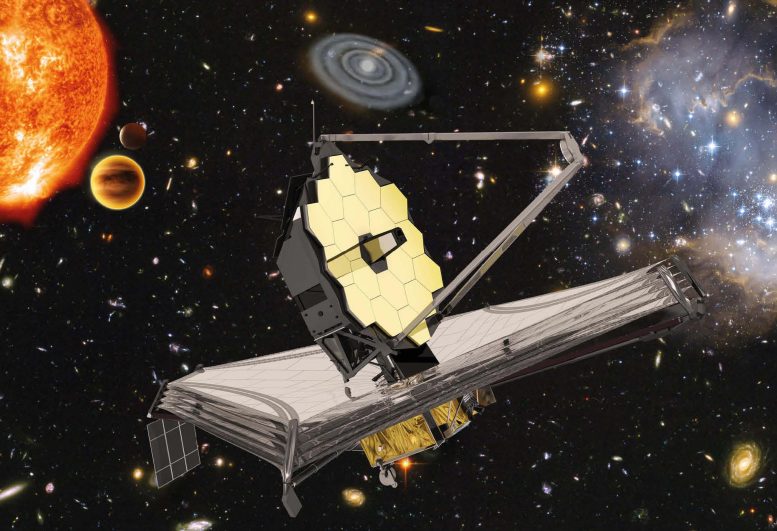
Artist’s impression of the NASA/ESA/CSA James Webb Space Telescope. Credit: ESA, NASA, S. Beckwith (STScI) and the HUDF Team, Northrop Grumman Aerospace Systems / STScI / ATG medialab
Some have called NASA’s James Webb Space Telescope the “telescope that ate astronomy.” It is the most powerful space telescope ever built and a complex piece of mechanical origami that has pushed the limits of human engineering. On December 22, 2021, after years of delays and billions of dollars in cost overruns, the telescope is scheduled to launch into orbit and usher in the next era of astronomy.
I’m an astronomer with a specialty in observational cosmology – I’ve been studying distant galaxies for 30 years. Some of the biggest unanswered questions about the universe relate to its early years just after the Big Bang. When did the first stars and galaxies form? Which came first, and why? I am incredibly excited that astronomers may soon uncover the story of how galaxies started because James Webb was built specifically to answer these very questions.
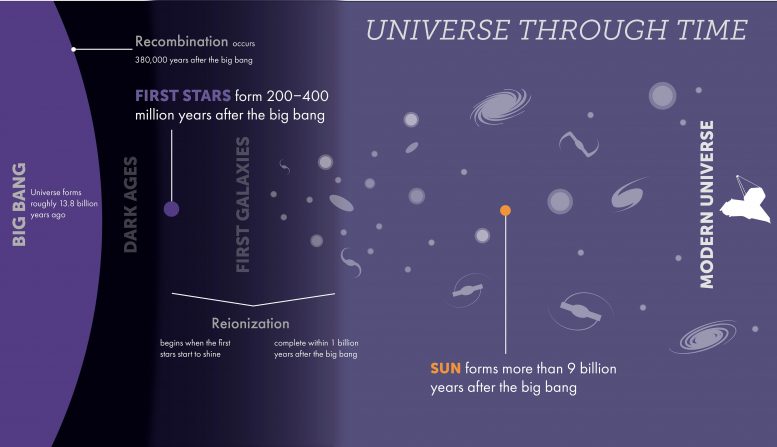
The Universe went through a period of time known as the Dark Ages before stars or galaxies emitted any light. Credit: STScI
The ‘Dark Ages’ of the universe
Excellent evidence shows that the universe started with an event called the Big Bang 13.8 billion years ago, which left it in an ultra-hot, ultra-dense state. The universe immediately began expanding after the Big Bang, cooling as it did so. One second after the Big Bang, the universe was a hundred trillion miles across with an average temperature of an incredible 18 billion °F (10 billion °C). Around 400,000 years after the Big Bang, the universe was 10 million light-years across and the temperature had cooled to 5,500 °F (3,000 °C). If anyone had been there to see it at this point, the universe would have been glowing dull red like a giant heat lamp.
Throughout this time, space was filled with a smooth soup of high-energy particles, radiation, hydrogen, and helium. There was no structure. As the expanding universe became bigger and colder, the soup thinned out and everything faded to black. This was the start of what astronomers call the Dark Ages of the universe.
The soup of the Dark Ages was not perfectly uniform and due to gravity, tiny areas of gas began to clump together and become more dense. The smooth universe became lumpy and these small clumps of denser gas were seeds for the eventual formation of stars, galaxies and everything else in the universe.
Although there was nothing to see, the Dark Ages were an important phase in the evolution of the universe.
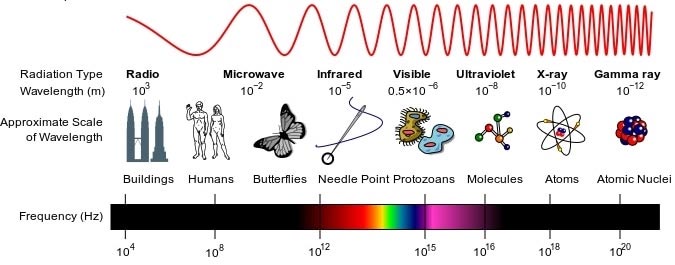
Light from the early universe is in the infrared wavelength – meaning longer than red light – when it reaches Earth. Credit: Inductiveload/NASA
Looking for the first light
The Dark Ages ended when gravity formed the first stars and galaxies that eventually began to emit the first light. Although astronomers don’t know when first light happened, the best guess is that it was several hundred million years after the Big Bang. Astronomers also don’t know whether stars or galaxies formed first.
Current theories based on how gravity forms structure in a universe dominated by dark matter suggest that small objects – like stars and star clusters – likely formed first and then later grew into dwarf galaxies and then larger galaxies like the Milky Way. These first stars in the universe were extreme objects compared to stars of today. They were a million times brighter but they lived very short lives. They burned hot and bright and when they died, they left behind black holes up to a hundred times the Sun’s mass, which might have acted as the seeds for galaxy formation.
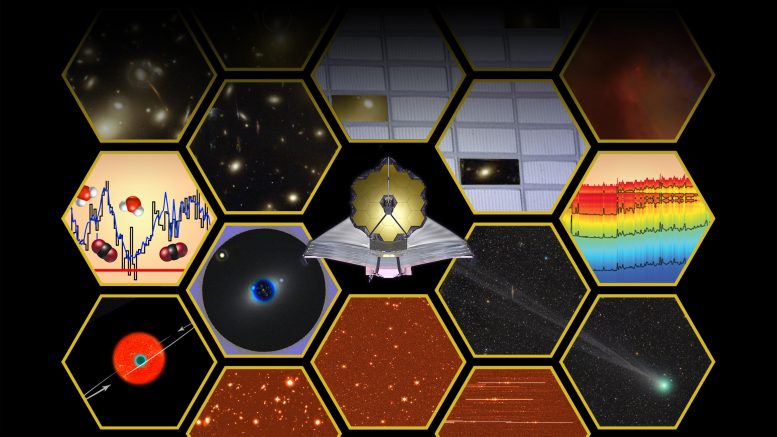
This artist’s illustration represents the scientific capabilities of NASA’s James Webb Space Telescope. Both imaging and spectroscopy will be central to the Webb mission. Credit: NASA, ESA, and A. Feild (STScI)
Astronomers would love to study this fascinating and important era of the universe, but detecting first light is incredibly challenging. Compared to massive, bright galaxies of today, the first objects were very small and due to the constant expansion of the universe, they’re now tens of billions of light years away from Earth. Also, the earliest stars were surrounded by gas left over from their formation and this gas acted like fog that absorbed most of the light. It took several hundred million years for radiation to blast away the fog. This early light is very faint by the time it gets to Earth.
But this is not the only challenge.
As the universe expands, it continuously stretches the wavelength of light traveling through it. This is called redshift because it shifts light of shorter wavelengths – like blue or white light – to longer wavelengths like red or infrared light. Though not a perfect analogy, it is similar to how when a car drives past you, the pitch of any sounds it is making drops noticeably.
Similar to how a pitch of a sound drops if the source is moving away from you, the wavelength of light stretches due to the expansion of the universe.
By the time light emitted by an early star or galaxy 13 billion years ago reaches any telescope on Earth, it has been stretched by a factor of 10 by the expansion of the universe. It arrives as infrared light, meaning it has a wavelength longer than that of red light. To see first light, you have to be looking for infrared light.
Telescope as a time machine
Enter the James Webb Space Telescope.
Telescopes are like time machines. If an object is 10,000 light-years away, that means the light takes 10,000 years to reach Earth. So the further out in space astronomers look, the further back in time we are looking.
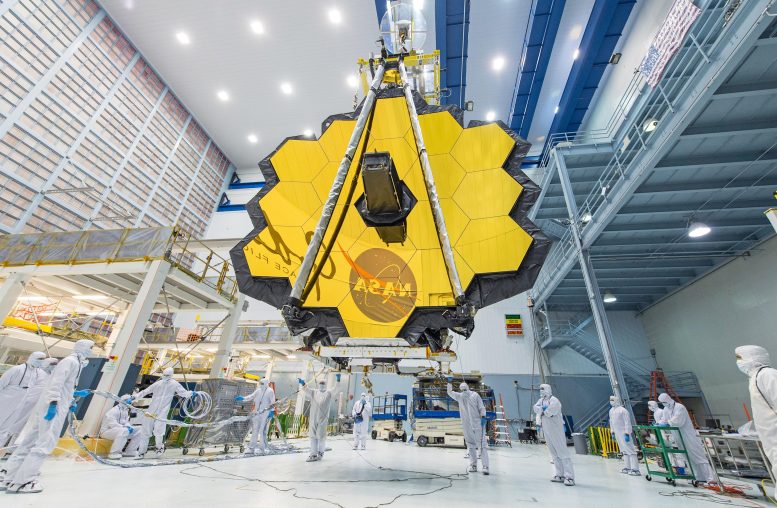
The James Webb Space Telescope was specifically designed to detect the oldest galaxies in the universe. Credit: NASA/Desiree Stover
Engineers optimized James Webb for specifically detecting the faint infrared light of the earliest stars or galaxies. Compared to the Hubble Space Telescope, James Webb has a 15 times wider field of view on its camera, collects six times more light and its sensors are tuned to be most sensitive to infrared light.
The strategy will be to stare deeply at one patch of sky for a long time, collecting as much light and information from the most distant and oldest galaxies as possible. With this data, it may be possible to answer when and how the Dark Ages ended, but there are many other important discoveries to be made. For example, unraveling this story may also help explain the nature of dark matter, the mysterious form of matter that makes up about 80% of the mass of the universe.
James Webb is the most technically difficult mission NASA has ever attempted. But I think the scientific questions it may help answer will be worth every ounce of effort. I and other astronomers are waiting excitedly for the data to start coming back sometime in 2022.
Written by Chris Impey, University Distinguished Professor of Astronomy, University of Arizona.
This article was first published in The Conversation.![]()








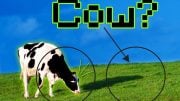
So the universe expand faster than the speed of light during the one second after it had formed? How long was that one second?
Where did you get that claim from in the article? There are several problems with the formulation “expand faster than the speed of light during the one second after it had formed”.
First, the article (and you) doesn’t describe the initial volume of the observable hot big bang universe. It is usually claimed to be ball sized, which was already up from earlier estimates but isn’t updated with the new observational constraints. Unless I’m mistaken the lower bound on inflationary energy now puts the initial volume to 1-10 meters across.
Second, the Hubble rate expansion is a frequency, the dimension of “km/s per Mpc” comes out as 1/time, and the local rate of time is constant at 1 s per s. So given an initial volume – of radius, say, that megaparsec – you can observe the expansion rate over it. But the relativistic universal speed limit applies to local observations of passing particles relative to each other, so is mostly unrelated to the global expansion rate “clock” frequency. There is no problem of a space volume expanding faster than the light that travels in it – it is what sets the observational universe cosmic horizon beyond which we can’t observe. The expansion accumulates over ever larger volumes until light can’t keep up.
One of the ways that inflation affected the universe before the hot big bang was to expand away any content, apart from its own quantum fluctuations it constantly generated, outside the observational volume. The expansion smoothed space if it wasn’t already smooth, and it cooled the inflationary vacuum to absolutely 0 K. In that sense the expansion overtook the universal speed limited photons – because it could.
No one knows for how long inflation took place. Those physicists that like to put the observational universe traditional limit of a Planck volume and exchange observed flat space with a curved de Sitter approximation may say it took a small amount of time. But inherently there is no natural limit to an exponential expansion of flat space, as under inflation (c.f. the analogous exponential expansion that dark energy makes the universe approach). A singularity of flat space would have needed a super-exponential expansion, which we don’t see. Potentially then, most natural I would say but I’m not a cosmologist, inflation was an eternal process when we look back. It was its quantum nature that randomly pushed the process energetically downhill towards the downslope observations have described, and after rolling down that slope ending up as our hot big bang universe when the potential energy was released as heat.
“the lower bound on inflationary energy now puts the initial volume to 1-10 meters across” – I should say that it puts the higher bound on an initial volume estimate in that range (unless I have made a mistake in the calculations).
Will webb find planet 9
The James Webb telescope survived the recent scare – a tension band snapped – and is scheduled to launch with only 4 days delay. If it survives to become operational, it is the new discoveries that excite me the most, albeit surveys are useful.
“Excellent evidence shows that the universe started with an event called the Big Bang 13.8 billion years ago, which left it in an ultra-hot, ultra-dense state.”
Impey should perhaps communicate with the theoretical cosmologists as well, since their part of the US Astro2020 Decadal Survey puts inflation before the Hot Big Bang based on excellent evidence [ https://www.nationalacademies.org/our-work/decadal-survey-on-astronomy-and-astrophysics-2020-astro2020 , C Report of the Panel on Cosmology ]:
“One of the fundamental discoveries of modern cosmology is that the primordial density fluctuations, the seeds of the structure of the universe observed throughout cosmic history, were created before the hot phase of the Big Bang.”
“The question of what process set the Hot Big Bang in motion and created the seeds of structure has been with us for many decades. Early theoretical developments, together with observations over the past two decades, have established the inflationary paradigm as the dominant picture in the field. In inflation, the universe went through an early period of accelerated expansion that smoothed out prior anisotropies, ending in a dramatic event that filled the universe with high-energy particles.”
There are 5 key observations underlying the LCDM model of the Hot Big Bang universe we live in. But there are 6 possible key observations, 4 already observed, underlying the inflationary model of modern inflationary hot big bang cosmology.
That’s exactly what I thought. A contradiction of natural law.
This story is the Science Religion’s version of the creation myth written to convince people of their main tenet that the universe is exclusively material and governed by knowable neural laws. But this may not be the case. Astronomers may be looking at the edges of a massive video game, a virtual reality, mistaking it for something real/ material. What is described in this article is a belief system, nothing more.
Dear Sir, the Text is too long and the facts and figures in it are too wide, hence it be a hard job for a layman to fully grasp its essence and significance. However I, being an MSc degree holder student of Botany, have truly enjoyed reading and knowing the details of cosmology it contains. Nonetheless, as they say “Scientist take nothing for granted, but ask questions even at the risk of irritating others…”,so I feel it incumbent to ask a few questions in order to clear some doubts in my mind, which you or some other expert may like to read and clarify, if feel worth answering.
First is, the original source of” Big bang” is presumed to be some “small” body, which blasted and the matter it contained began to expend, in all directions, in the universe. Later on stars, planets, galaxies etc were formed, and they are still inflating, as you have told all the details of. Right, but I want to know as to how much small that original body was or could be which have transformed into billions of galaxies/stars, and of what elements/atoms that original body was made?? Were those elements the same as we now find on earth and elsewhere in the universe; if the same, how they were compressed togather; if different how can and under what physical laws new elements/atoms were created. Similarly, what factors caused the Big Ban and what hidden force is pushing all these stars and galaxies on and on for the last 13.8 billion years, with no end in sight; how all the elements and their respective atomic structure and sub-atomic particles (proton, neutrons, electrons et al) were created and bonded togather, each with a specific structucture, and when that making of different elements took place,that is, after or prior to Big ban.
Similarly, if the James Webb Telescope will/could detect the light coming from galaxies 10,000 light years away from earth, what and how it could be find out as at how much light years are Sun and earth from the original locus of Big bang.
There could be very many other questions too, yet I hope these could suffice to make the picture of Big Bang and known Cosmos clear for all students of science.
Accept all THANKS in advance, please.
The big bang happened 13 billion years ago. Picture in your head the massive explosion traveling in every directionn away from its center point at the speed of light. Our universe slowly takes shape in the middle of this blast, also traveling away from said center point. Now they want to look back to see the blast at the earliest point possible. But the initial flash is gone, its been traveling out from the center at the speed of light for 13 billion years, our universe is in the middle somewhere. To see the light would mean trying to see a light that is traveling away from us. There is no possible way to see the old light. It is still traveling away from the center. Its kind of like a car drives west at 100 miles per hour. We follow him 6 months after he left and we are traveling 10 mph. We will never catch him or see him again. Logically doesnt work.
I’m fairly certain that the initial expansion was much faster than the speed of light. Particles don’t have to travel any speed for a singularity to expand from a single point into a unimaginable void. I’m also quite sure that the leading theory is that the expansion has sped up even more sometime in the past several billion years. It would seem that if there was actually a big bang and expansion holds up, and if dark matter actually exists making up over 3/4ths of our universe, that dark matter and expansion are likely directly related to one another. I don’t think we can completely rule out the possibility that our universe is eternally expanding and that there is no limit to size. For all we know our universe is merely a quantum particle within a universe that is that much larger than the one we perceive our self to be in, or that there are no fundamental particles…perhaps our science just has not advanced enough for microscopes and telescopes to see this much? As above, so below.
Since the earth is over 4 billion years old and the universe is expanding, is it theoretically possible for us to view the light traveling from the ancient earth ?
Planets don’t usually emit a great deal of light. They reflect the light of stars . Moreover, the webb space telescope is going to remain in our solar system. It will take fantastic photographic images of the earth. Since we won’t be billions of millions of even a single light year away from the telescope…the images will be virtually in real time. By the time they are transmitted back to earth and published for us to see, we will be looking at images of earth that are from a couple days or weeks before. The galaxies that webb will capture are millions and billions of light years away, meaning that the photons travelled that far (minus expansion) to be captured by the Webb telescope. These galaxies are so unfathomably far away that the only way to describe the distance is how many million or billion years it would take a photon traveling at the speed that photons travel, to get from there to here. Or we could say X00,000,000,000,000,000,000,000,000,000,000,000,000,000,000,000,000,000,000,000,000,000,000,000,000,000,000,000,000,000,000,000 miles away. But that doesn’t put the distance into clear perspective for most people.
So let me get this straight. You say that there was a big bang that started all this right? But then you say it could’ve taken 200-400 million years to produce the first light???? So now the second question is, if there was a big bang and something exploded, don’t you think there wouldn’t been light then? Something just don’t add up.
Most of this is beyond my expertise but a question was asked that was too conveniently dismissed. “How long was that one second?” The article posits that an expansion of 100 trillion miles occurred in one second. That’s over 500 million times the speed of light.
We know that satellites have time compensation. Isn’t it realistic that a perceived “second” becomes much longer, maybe even years, for the matter within that event? Of course it is! The theories about our origin universe do themselves a disservice by suggesting incredible speeds and ignoring their effect on time.
No one observed the first second of the universe with a nuclear clock and compared their time in relation to another observer at a different location, different nuclear clock. This is all theoretical. It was theorized by a scientist on the planet earth so the second would be as long as a second is on planet earth at the time it was theorized. Just an ordinary every day one second.
I just want to say obviously I am not as intelligent as you like to call it but I AM TRYING TO UNDERSTAND THIS WHOLE THING BECAUSE I FIND IT VERY INTERESTING. I BELIEVE THAT THE INITIAL COMMENT ABOUT HOW LONG WAS THAT SECOND IS EXTREMELY IMPORTANT AND I THINK THAT R.J WALSH’S COMMENT NOW THIRD TO THE LAST REALLY SUMS UP WHAT ALOT OF US ARE THINKING AND IT WAS WELL PUT AND EASY TO FOLLOW AND UNDERSTAND WHICH THE WHOLE REASON THEY POST ARTICLES LIKE THIS IS NOT FOR THE GENIUSES WHO ALREADY KNOW BUT FOR THOSE OF US THEY ARE TRYING TO SHOW WHAT COOL THINGS NASA IS DOING WHAT THEY ARE TRYING TO ACHIEVE HOW IT RELATES TO US AS HUMAN BEINGS FOR FUTURE GENERATIONS AND I DONT KNOW IF IT IS BECAUSE THE MAN WHO FIRST COMMENTED BACK TO THE QUESTION CAME OFF AS KIND OF RUDE AND SHORT LIKE HOW DARE WE THINK OF SUCH A IDIOTIC QUESTION WHY WOULD WE THINK THAT “WHERE IN THE TEXT DID IT SAY” DUDE THATS WHAT CAME TO MILLIONS OF PEOPLES MINDS WHEN THEY READ THIS ARTICLE PERIOD MAYBE ITS THE LANGUAGE BARRIER OR THE FACT THAT THIS CONVERSATION IS HAPPENING THROUGH TEXT AND NOT VOICE AUDIO SO WE HAVE OUR OWN INTERPRETATION AND TAKE OFFENSE OR NOT ….WHEN WE SHOULD BE PRAISED FOR REALLY EVEN CARING BECAUSE THIS IS ONE HARD TO UNDERSTAND DULL PIECE OF WRITING AS EXCITING AS THE EXPERIMENT IS !!!! I just wanted to say this there is never a dumb question just ignorant dumb people ….. Happy holidays my fellow human beings peace love and happiness to you and yours
It will show great wonders of the universe it will not look back in time because the universe and earth were created by GOD 6000 years ago Genisis Chapters 1 and 2 many other bible verses to numerous to quote here in the bible.
Blah,blah,blah!
That artist’s conception of the JWT is a total failure: the orientation to the sun is wrong. How was that ever missed while editing the article? Makes one wonder about the quality of the article itself
So much misinformation in the comments. 1st, absolute zero Kelvin isn’t possible. That’s already been proven. 2nd, time is relative. Every heard of space-time? Look up Einstein’s theory of general relativity if you need help understanding that concept. I’ll admit it’s a lot to take in. Also Adams can come together to make new elements. Think about H2O(water) hydrogen plus two oxygen atoms. Remember the periodic table of elements in school? Well that’s the building blocks of all matter. Ever wonder what they mean when they say ” atomic mass of an element?” The answers are there if u look. Universe is knowable
Good post, it fits with my book that I started back in 1990 and finished in 2018. I see some people don’t agree with you, but what you have here is close to what King Solomon wrote around 3000 years ago. King Solomon was God inspired. My book is called “The Seed of the Universe” and that’s what this time frame is about. I used quasars as the first elements because they could have been the origin of antimatter because they spin in two totally opposite direction at the same time. (Antimatter is a mirror image of matter). One thing, in hopes, we might find out if everything keeps going as smooth as it’s been going. God must be behind this project to prove the Creation stories true.